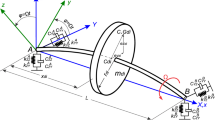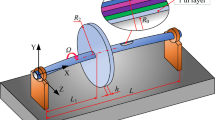Abstract
This paper presents a finite element method to analyze the free vibration of a flexible HDD (hard disk drive) composed of the spinning disk–spindle system with fluid dynamic bearings (FDBs), the head–suspension–actuator with pivot bearings, and the base plate with complicated geometry. Finite element equations of each component of an HDD are consistently derived with the satisfaction of the geometric compatibility in the internal boundary between each component. The spinning disk, hub and FDBs are modeled by annular sector elements, beam elements and stiffness and damping elements, respectively. It develops a 2-D quadrilateral 4-node shell element with rotational degrees of freedom to model the thin suspension efficiently as well as to satisfy the geometric compatibility between the 3-D tetrahedral element and the 2-D shell element. Base plate, arm, E-block and fantail are modeled by tetrahedral elements. Pivot bearing of an actuator and air bearing between spinning disk and head are modeled by stiffness elements. The restarted Arnoldi iteration method is applied to solve the large asymmetric eigenvalue problem to determine the natural frequencies and mode shapes of the finite element model. Experimental modal testing shows that the proposed method well predicts the vibration characteristics of an HDD. This research also shows that even the vibration motion of the spinning disk corresponding to half-speed whirl and the pure disk mode are transferred to a head–suspension–actuator and base plate through the air bearing and the pivot bearing consecutively. The proposed method can be effectively extended to investigate the forced vibration of an HDD and to design a robust HDD against shock.
















Similar content being viewed by others
References
Choi CK, Lee TY (2001) Development of flat shell elements with directly modified non-conforming modes and analysis of shell structures. Department of Civil Engineering, Korea Advanced Institute of Science and Technology, Daejeon
Cook RD, Malkus DS, Plesha ME (1989) Concepts and applications of finite element analysis, 3rd edn. Wiley, New York
Donea J, Lamain LG (1987) A modified representation of transverse shear in quadrilateral plate elements. Comput Methods Appl Mech Eng 63:183–207
Gao F, Yap FF, Yan Y (2005) Modeling of hard disk drives for vibration analysis using a flexible multibody dynamics formulation. IEEE Trans Magn 41(2):744–749
Hinton E, Owen DRJ (1977) Finite element programming. Academic, London
Hughes TJR, Brezzi F (1989) On drilling degrees of freedom. Comput Methods Appl Mech Eng 72:105–121
Jang GH, Jeong SW (2003) Analysis of a ball bearing with waviness considering the centrifugal force and gyroscopic moment of the ball. ASME J Tribol 125(3):487–498
Jang GH, Kim JY (1999) Calculation of dynamic coefficients in a hydrodynamic bearing considering five degrees of freedom for a general rotor-bearing system. ASME J Tribol 121(3):499–505
Jang GH, Han JH, Seo CH (2005) Finite element modal analysis of a spinning flexible disk–spindle system in a HDD considering the flexibility of complicated supporting structure. Microsyst Technol 11(7):488–498
Jayson EM, Smith PW, Talke FE (2003) Shock modeling of the head–media interface in an operational hard disk drive. IEEE Trans Magn 39:2429–2431
Lehoucq RB, Sorensen DC (1996) Deflation techniques for an implicitly restarted Arnoldi iteration. SIAM J Matrix Anal Appl 17(4):789–821
Saad Y (1995) Iterative methods for sparse linear systems. PWS Publishing Company, Boston
Tseng CW, Shen JY, Shen IY (2003) Vibration of rotating-shaft HDD spindle motors with flexible stationary parts. IEEE Trans Magn 39:794–799
Xu LM, Guo N (2003) Modal testing and finite element modelling of subsystem in hard disk drive. Mech Syst Signal Process 17(4):747–764
Author information
Authors and Affiliations
Corresponding author
Rights and permissions
About this article
Cite this article
Jang, G.H., Seo, C.H. & Lee, H.S. Finite element modal analysis of an HDD considering the flexibility of spinning disk–spindle, head–suspension–actuator and supporting structure. Microsyst Technol 13, 837–847 (2007). https://doi.org/10.1007/s00542-006-0276-y
Received:
Accepted:
Published:
Issue Date:
DOI: https://doi.org/10.1007/s00542-006-0276-y




